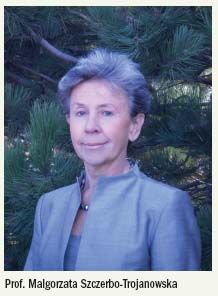First Eastern-based ECR president puts renewed emphasis on training
When it comes to fighting turf battles, ECR 2010 president Prof. Malgorzata Szczerbo-Trojanowska is in an enviable position because she has a powerful ally.
When it comes to fighting turf battles, ECR 2010 president Prof. Malgorzata Szczerbo-Trojanowska is in an enviable position because she has a powerful ally.
“I am very lucky that I do not really have them because my husband (Prof. Tomasz Trojanowski) is head of the department of neurosurgery in our hospital!” she said. “I insisted that vascular surgery should be part of the department of radiology, and that has helped us develop a strong neurointerventional unit.”

Along with her predecessor, Prof. Marian Klamut, she established one of Europe's earliest interventional radiology departments in 1972 at the Medical University in Lublin, Poland. They also founded the interventional section of the Polish radiological society, Klamut becoming the section's president and Szczerbo-Trojanowska being the secretary. Szczerbo-Trojanowska took over as the Medical University's head of interventional radiology in 1995 and chair of radiology in 1999.
Intervention remains her overriding passion-particularly embolization, angioplasty, aortic aneurysm endovascular treatment, and neurointervention- but right now her prime concern is the success of ECR.
“It is a great honor for me to become the first president from the East of Europe. To be honest, I never expected it, but it makes me feel so proud and happy,” she said. “I think my appointment reflects increasing recognition of the importance of Poland and other Eastern countries.”
She's very keen for ECR to continue its vital role in the training and education of all radiologists, but particularly those from the East. Compared with when ECR first moved to Vienna in 1991, it is now much easier for Eastern-based doctors to obtain travel visas. But training opportunities remain quite limited and fees are high. Young radiologists need more support and assistance, she said.
In this respect, Prof. Szczerbo- Trojanowska thinks the expanded Professional Challenges series will prove popular at ECR 2010. The five sessions will concentrate on teaching and education, PET/CT in oncologic imaging, the radiologist of the future, radiology and the law, and radiation protection. The category courses will look at the spine, abdominal emergencies, and lung diseases, and two minicourses will be devoted to the liver and extremity joint MRI.
The organizers of ECR 2010 have accepted 4105 abstracts. Italy accounts for 624 of the accepted abstracts, followed by Germany (428), Spain (354), U.K. (331), Japan (294), China (271), Korea (233), U.S. (152), Portugal (120), France (117), Greece (110), Austria (104), the Netherlands (102), and Poland (97). Neuroradiology accounted for 436 accepted abstracts, followed by interventional radiology (374), musculoskeletal (371), cardiac (350), genitourinary (337), abdominal viscera (332), chest (308), GI tract (292), breast (250), vascular (233), head and neck (187), computer applications (143), pediatric (138), physics (120), contrast media (67), radiographers (64), molecular imaging (58), and audit (45).
A total of 2281 scientific papers were submitted, of which 880 were accepted for the 88 sessions, giving a rejection rate of 61.4%. For the scientific and educational exhibits, the ESR's executive council decided to accept all exhibits above a certain score and to publish them in the EPOS (Electronic Poster System). This new policy is the main reason for the large number of acceptances compared with previous congresses.
The number of New Horizons sessions has been doubled to four this year. Friday's session will focus on functional imaging in CT, while Saturday's seminar will seek to define biomarkers and outline their uses in MRI and PET. Sunday's two sessions will address MRI of the lungs and hybrid imaging.
Along with Poland and Saudi Arabia, Argentina will be a host nation at ECR 2010, becoming the first South American country to take part in the “ESR meets…” program.
“Our country is going through a significant social crisis,” said Prof. Alfredo Buzzi, president of the Argentine society of radiology. “The National Public Health Plan is poor, there are delays in the completion of studies, medical equipment is quite old. These problems affect not only diagnostic imaging, but also all fields of medicine. In private medicine, they are able to offer better services and the medical equipment is of high quality.”
ECR will take place from 4 to 8 March. More information is available at myESR.org.
GE HealthCare Debuts AI-Powered Cardiac CT Device at ACC Conference
April 1st 2025Featuring enhanced low-dose image quality with motion-free images, the Revolution Vibe CT system reportedly facilitates improved diagnostic clarity for patients with conditions ranging from in-stent restenosis to atrial fibrillation.
The Reading Room Podcast: Current Perspectives on the Updated Appropriate Use Criteria for Brain PET
March 18th 2025In a new podcast, Satoshi Minoshima, M.D., Ph.D., and James Williams, Ph.D., share their insights on the recently updated appropriate use criteria for amyloid PET and tau PET in patients with mild cognitive impairment.